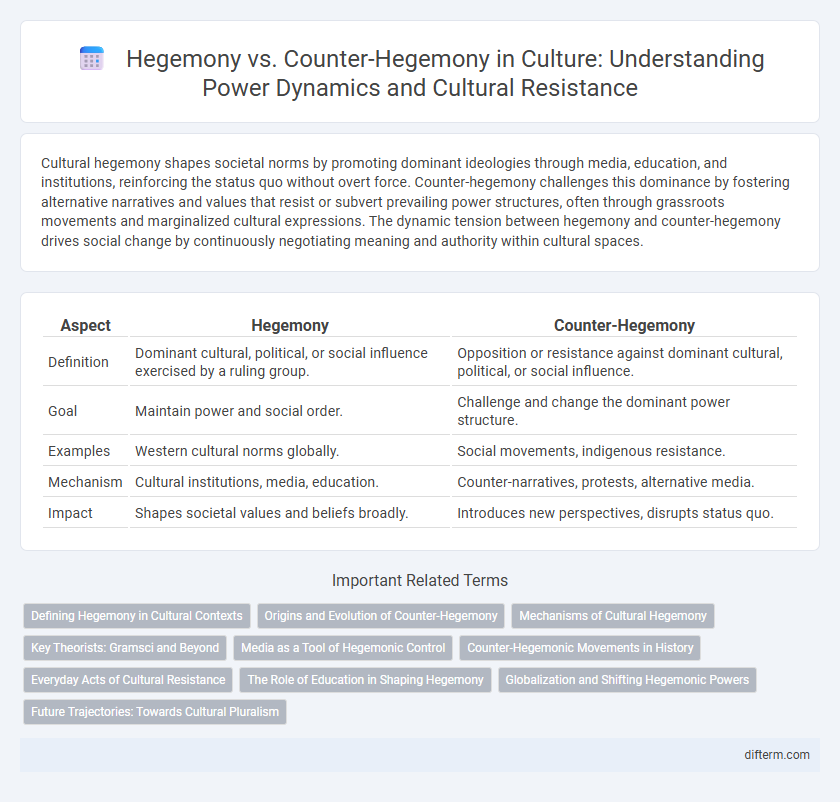Cultural hegemony shapes societal norms by promoting dominant ideologies through media, education, and institutions, reinforcing the status quo without overt force. Counter-hegemony challenges this dominance by fostering alternative narratives and values that resist or subvert prevailing power structures, often through grassroots movements and marginalized cultural expressions. The dynamic tension between hegemony and counter-hegemony drives social change by continuously negotiating meaning and authority within cultural spaces.
Table of Comparison
| Aspect | Hegemony | Counter-Hegemony |
|---|---|---|
| Definition | Dominant cultural, political, or social influence exercised by a ruling group. | Opposition or resistance against dominant cultural, political, or social influence. |
| Goal | Maintain power and social order. | Challenge and change the dominant power structure. |
| Examples | Western cultural norms globally. | Social movements, indigenous resistance. |
| Mechanism | Cultural institutions, media, education. | Counter-narratives, protests, alternative media. |
| Impact | Shapes societal values and beliefs broadly. | Introduces new perspectives, disrupts status quo. |
Defining Hegemony in Cultural Contexts
Hegemony in cultural contexts refers to the dominance of a particular social group's values, beliefs, and norms that shape societal standards and perceptions. This cultural dominance is maintained through institutions such as media, education, and religion, which reinforce the ruling ideology as natural and inevitable. Understanding hegemony involves analyzing how power structures influence cultural consent and social control beyond mere political or economic dominance.
Origins and Evolution of Counter-Hegemony
Counter-hegemony originated as a critical response to dominant power structures, conceived by Antonio Gramsci to challenge cultural and ideological control maintained by ruling classes. It evolved through social movements and intellectual resistance that aimed to construct alternative worldviews and promote marginalized voices. This dynamic process reflects ongoing struggles where subordinated groups contest prevailing norms to achieve cultural autonomy and social change.
Mechanisms of Cultural Hegemony
Mechanisms of cultural hegemony operate through media control, education systems, and institutional practices that normalize dominant ideologies, shaping public consciousness to accept prevailing power structures as natural. This process involves the subtle reinforcement of cultural norms and values that marginalize alternative perspectives, ensuring consent rather than coercion. Counter-hegemony challenges these mechanisms by promoting alternative narratives and fostering critical awareness to disrupt dominant cultural paradigms.
Key Theorists: Gramsci and Beyond
Antonio Gramsci's theory of cultural hegemony emphasizes how dominant groups maintain power through consensual cultural leadership rather than direct force. Counter-hegemony involves challenging this dominance by promoting alternative cultural narratives and practices that resist oppressive ideologies. Scholars beyond Gramsci, such as Stuart Hall and Raymond Williams, expand on this by exploring media, ideology, and cultural resistance as forms of contesting hegemonic structures in society.
Media as a Tool of Hegemonic Control
Media serves as a powerful instrument of hegemonic control by shaping public perception and reinforcing dominant cultural narratives. Through selective representation and framing, media perpetuates existing power structures and marginalizes counter-hegemonic voices. The control over media content enables hegemonic forces to maintain ideological dominance and influence societal values at a mass scale.
Counter-Hegemonic Movements in History
Counter-hegemonic movements have historically challenged dominant power structures by promoting alternative cultural narratives and social practices that resist mainstream ideologies. Key examples include the Civil Rights Movement in the United States, which confronted racial segregation and inequality, and the anti-colonial struggles in India led by figures like Mahatma Gandhi, advocating for self-determination and cultural revival. These movements employ tactics such as grassroots organizing, protest, and the creation of parallel institutions to disrupt hegemonic control and foster social transformation.
Everyday Acts of Cultural Resistance
Everyday acts of cultural resistance challenge dominant hegemony by subverting mainstream narratives through grassroots practices, language, and symbols embedded in daily life. These subtle yet powerful actions create spaces for marginalized voices, fostering alternative identities and social relations that undermine prevailing power structures. By adopting and repurposing cultural artifacts, communities engage in counter-hegemonic strategies that disrupt cultural conformity and promote emancipatory change.
The Role of Education in Shaping Hegemony
Education functions as a critical tool in maintaining cultural hegemony by transmitting dominant ideologies and social norms through curricula and institutional practices. Schools often reinforce the values and power structures favored by ruling classes, shaping students' worldviews to align with prevailing hegemonic interests. Counter-hegemony arises when alternative educational frameworks challenge these dominant narratives, fostering critical consciousness and empowering marginalized groups to resist ideological control.
Globalization and Shifting Hegemonic Powers
Globalization accelerates the diffusion of cultural norms, challenging established hegemonies by amplifying diverse voices and fostering counter-hegemonic movements that resist dominant power structures. Shifting hegemonic powers, such as the rise of China and digital platforms, reshape global cultural dynamics by promoting alternative narratives that contest Western-centric ideologies. These transformations destabilize traditional cultural hegemonies, enabling the formation of more pluralistic and contested cultural landscapes worldwide.
Future Trajectories: Towards Cultural Pluralism
Hegemony maintains dominant cultural narratives through pervasive social institutions, while counter-hegemony challenges this dominance by promoting alternative perspectives and marginalized voices. Future trajectories point towards cultural pluralism, emphasizing coexistence and dialogue among diverse cultural identities, which fosters inclusivity and mutual recognition. Advancements in digital media and global interconnectedness accelerate the diffusion of counter-hegemonic ideas, reshaping cultural landscapes towards more equitable power distributions.
Hegemony vs Counter-hegemony Infographic

 difterm.com
difterm.com